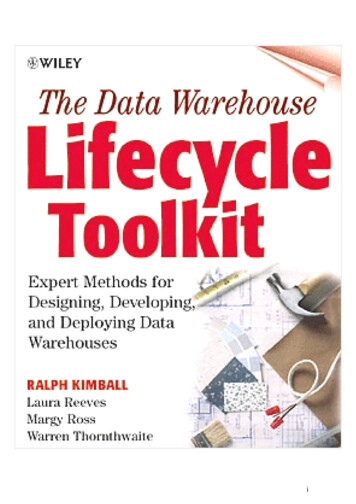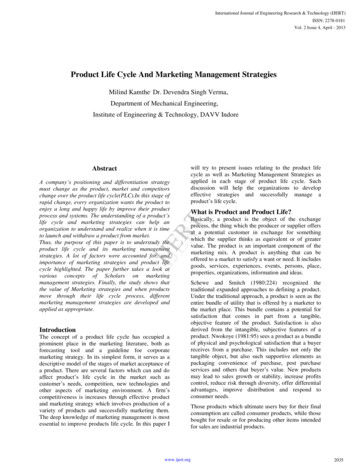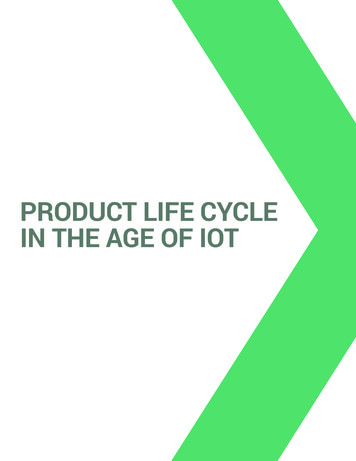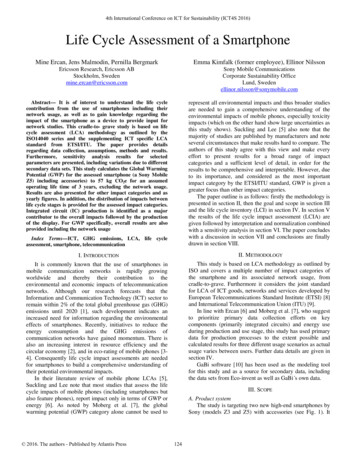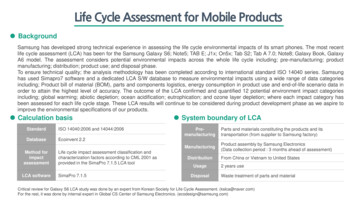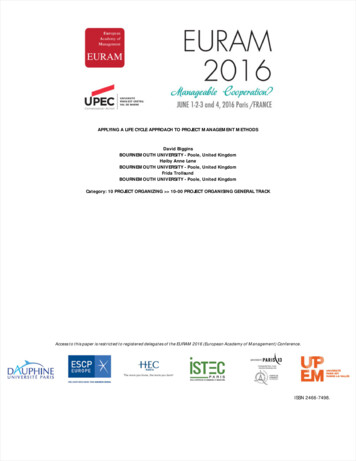
Transcription
APPLYING A LIFE CYCLE APPROACH TO PROJECT MANAGEMENT METHODSDavid BigginsBOURNEMOUTH UNIVERSITY - Poole, United KingdomHøiby Anne LeneBOURNEMOUTH UNIVERSITY - Poole, United KingdomFrida TrollsundBOURNEMOUTH UNIVERSITY - Poole, United KingdomCategory: 10 PROJECT ORGANIZING 10-00 PROJECT ORGANISING GENERAL TRACKAccess to this paper is restricted to registered delegates of the EURAM 2016 (European Academy of Management) Conference.ISSN 2466-7498.
Applying a life cycle approach to project management methodsABSTRACTProject management is increasingly important to organisations because projects are the methodby which organisations respond to their environment. A key element within project managementis the standards and methods that are used to control and conduct projects, collectively known asproject management methods (PMMs) and exemplified by PRINCE2, the Project ManagementInstitute’s and the Association for Project Management’s Bodies of Knowledge (PMBOK andAPMBOK. The purpose of this paper is to apply the life cycle approach to PMMs, stimulate debateon the accuracy and merits of the life cycle approach and to facilitate the development of the lifecycle in the future. Currently no life cycle process exists for PMMs. Developed from desk-basedresearch and empirical evidence, a life cycle has been proposed consisting of five stages: Select,Embed, Tailor, Operate and Develop. The stages are explained and a call made for furtherresearch to develop and validate the life cycle model.Keywords: Project management methods
Applying a life cycle approach to project management methodsAbstractProject management is increasingly important to organisations because projects are themethod by which organisations respond to their environment. A key element within projectmanagement is the standards and methods that are used to control and conduct projects,collectively known as project management methods (PMMs) and exemplified by PRINCE2,the Project Management Institute’s and the Association for Project Management’s Bodies ofKnowledge (PMBOK and APMBOK).The purpose of this paper is to apply the life cycle approach to PMMs, stimulate debate onthe accuracy and merits of the life cycle approach and to facilitate the development of the lifecycle in the future. Currently no life cycle process exists for PMMs.Developed from desk-based research and empirical evidence, a life cycle has been proposedconsisting of five stages: Select, Embed, Tailor, Operate and Develop. The stages areexplained and a call made for further research to develop and validate the life cycle model.Keywords: Project management methods, life cycle1
IntroductionThe importance of projects and project management methods"We are in one of those great historical periods that occur every 200 or 300 years whenpeople don't understand the world anymore, and the past is not sufficient to explain thefuture" (Peter Drucker quoted in Cameron and Quinn 2011 p1). It is often stated by authorslike Drucker and others that modern organisations operate in an increasingly competitive areabut the data do back up the claims (Cleland and Ireland 1999; Stubbart and Knight 2006;Strangler and Arbesman 2012; Boehm et al 2012). The literature underlines the need fororganisations to change in order to survive with projects being used to facilitate change. AsPinto (2013 p24) says “Project are one of the principal means by which we change ourworld . the means through which to achieve these challenges remains the same: projectmanagement.” The Anderson Economic Group estimate that in 2016 32.6 million peopleacross 11 countries will be involved in organisational projects (ISO 2012a). As the number,size, complexity and importance of projects within organisations grow (Pinto 2013), so do therequirement to ensure that projects perform well. Increasingly organisations are looking forways in which project success can be enhanced and one such factor is the use of a projectmanagement method (Wells 2012).There is no agreed definition of PMMs. We define PMMs as the standard organisational orstrategic level processes and procedures used to execute projects rather than the tools andtechniques such as risk management and scope management that are deployed at theoperational level to manage individual project delivery.Table 1 lists the current, distinct and dominant methods and standards that can be used to runprojects.2
Table 1: Project management methodsMethodDescriptionAPM BOKAssociation for Project Management Body of KnowledgeDeveloped by the Association for Project ManagementA body of knowledge which, in the 6th edition (2012), covers thesections of context, people, diversity and interfaces. The scope of theAPMBOK is wide and encompasses portfolio and programmemanagement, soft skills, and ‘interfaces’ to accounting, health andsafety, sustainability etc.(APM 2012)BS 6079(BSI 2010)ISO 21500(ISO 2012b)P2M(PM2 2005)PMBOK(PMI 2013a)PRINCE2: 2009(OGC 2009)British Standard 6079-1:2010. Project management. Principles andguidelines for the management of projectsOwned by the British Standards InstitutionA set of guidelines covering many types of projects and providingguidance on sponsorship, management, planning, undertakingprojects and application of project management techniques.Influenced by the APMBOK.International Organization for Standards 21500:2012 Guidance onproject managementOwned by the ISOContains concepts and processes for project management that areconsidered good practice, usable by any type of organisation for anyproject. Influenced by the PMBOK.A Guidebook of Project and Program Management for EnterpriseInnovation ‘P2M’Developed by the Project Management Association of JapanA project and programme management framework focused on addingvalue while delivering successful projects. The P2M ProjectManagement Tower consists of entry criteria, project and programmemanagement processes and frame elements (eg risk, finance etc).A Guide to the Project Management Body of KnowledgeOwned by the Project Management InstituteFirst mooted in 1986, the first edition was published in 1996 and isupdated every four years. Consists of five process groups (initiating,planning, executing, monitoring and controlling, and closing) and 10knowledge areas. There are four million copies of the PMBOK inprint (PMI 2012b)Projects in Controlled EnvironmentsOwned by AxelosWith the 2009 edition, the method was simplified and made easier tocustomise. Focus on the seven principles of the business case,organisation, plans, risks, progress, quality and issues/changes.3
The extent to which the methods are used in organisations is unclear with conflictinginformation being presented from multiple, small, often national studies (White and Fortune2002; PWC 2004; Fortune et al 2011; PWC 2012).While some organisations use PMMs in their pure form, many organisations will tailor themethod to their own requirements. This can be visualised as a continuum with full alignmentwith the method at one end and little or no alignment at the other (Biggins 2015). Whetherpure or tailored, project management methods are important because they are a factor insuccessful projects due of the standardisation and credibility they bring to an organisationthrough a set of common practices, tools and techniques, a shared vocabulary and way ofworking (Eskerod and Östergren 2000; Pitagorsky 2003; Garcia 2005; OGC 2009; Chin andSpowage 2010; Wells 2012; PMI 2013a; Wells 2013). The adoption of a method is oneapproach adopted to raise the maturity of the project practices within an organisation withresearch showing that the more mature an organisation’s processes, the more successful it is(Ibbs and Kwak 2000; PWC 2004; IBM 2008; Swanson 2012).Project management methods are deserving of further research because PMMs appearconsistently in the Standish CHAOS reports as contributors to project management failure(Wells 2012). Charvat (2003) notes how the adoption of a PMM by an organisation is astrategic decision.The configuration of resources, processes and activities under theumbrella of a PMM can generate a strategic organisational capability (Johnson et al 2008).Strategic decisions such as those to adopt a PMM can be long lasting. The authors arecurrently working with a national insurance company in the UK who continues to use thesame PPM that it developed 9 years ago. Measuring the life of PMMs in years is common toall other organisations with whom we have worked. The rationale for this paper is to proposea PMM life cycle. Such a model could have a positive influence on the part that PMMs play4
in organisational project delivery because of the new perspective it offers and the insightsgained into why PMMs contribute to failure and how their strategic benefit can be increased.In this paper we propose a model for the application of a life cycle model to PMMs and, in sodoing, fill a gap in knowledge because, as far as we are aware, no author has applied a lifecycle approach to PMMs.Theoretical underpinningsThe life cycle approachBiological life cycles of birth, growth, maturity, decline and death are the basis for life cyclesin business. The cycle of mortal biological life is seen as being applicable to a wide varietyof business entities. With it origins in product pricing in the 1950s (Dean 1950), the lifecycle was presumed to be a widely understood concept within a decade (Levitt 1965). Sincethen life cycle approaches has continued to be developed and expanded (Cao and Zhao 2011).The term ‘life cycle’ is now used in many disciplines and in differing contexts and there arelife cycles for organisations, products, software development, information technology andprocesses.The life cycle perspective provides a beneficial framework from which to structure a holisticview of an entity because the approach allows all of its aspects to be assessed in a systematicway. Each life cycle is composed of stages. A stage is defined as a major period in theentity’s life that is distinguishable from what went before and after it. The perspectiverecognises and highlights that there are different factors that affect the entity at each stage ofits life. A life cycle can be used to gain understanding and control, for operational planningand for forecasting/predicting (Kotler and Keller 2012).5
The analogy with biological life may be problematic. People pass through the human lifecycle at largely predictable time with the boundaries between stages being well defined eitherby convention or in law. There is also the definitive end that bounds biological existence.Looking at other entities as though they were analogous to biological processes can distortthe view and impose expectations on how the life cycle will linearly progress where suchexpectations are only partially valid or even completely invalid.Critics point out thatapplying the approach incorrectly can involve costly mistakes and mean that opportunitiesare missed (Polli and Cook 1969; Dhalla and Yuspeh 1976) and some question the validity ofthe approach (Mercer 1993). The life cycle approach creates an idealised view of linearityand predictability and focuses attention on the stages and activities that are defined in themodel. This can mean that the inappropriate application of a model or an incorrect model canhave negative results but this criticism is relevant to all models and theories which are, afterall, no more than simplified abstractions of complex environments. Users should thereforeapproach life cycles with caution and with a critical appreciation of the benefits and pitfallsof their use.Defining a life cycle for PMMsAs the term life cycle can be applied in many areas, it is important to define the scope of thispaper and what exactly is meant by a PMM life cycle. By PMM life cycle, we mean thestages that an organisation will go through when choosing a method for managing projects,introducing the method into the organisations, executing projects using the method’sprocesses and finally maintaining and enhancing the method.In defining a PMM life cycle, we are asserting that PMMs have a limited life, that the use ofa PMM passes through all stages of the life cycle and that, at each stage, different challengesand opportunities are presented to the organisation using the PMM.6
This paper focuses a life cycle relevant to project level management. The linking of projectsto programmes and programmes to portfolios and whether programmes and portfolios have asimilar life cycle is outside the scope of this current analysis.Within the domain of project management, projects also possess life cycles which arecommon stages within the life of the project that are often associated with a sector such aspharmaceuticals, software development and construction and which set out how projects inthose sectors are typically divided into phases (Pinto 2013). From a hierarchical perspective,project life cycles are encompassed within the PMM life cycle in the Operate stage.Research designThis exploratory research sought to create a life cycle model for PMMs, comprised deskbased research underpinned by empirical, practitioner experience. PMM information camefrom manuals, bodies of knowledge and related books, journal articles and conference papers.The source for life cycle data was books, journal articles and conference papers. Whilecontaining no primary data, the research design sought to develop a life cycle model forPMMs that could be justified, based on the available literature. The life cycle was createdfrom an evaluation of a range of existing models. The PMMs were subjectively analysed tolink chapters or sections of the relevant publications to stages in the proposed life cycle.A life cycle can be viewed from different perspectives. For this paper, the perspective of theorganisation is adopted because an organisation goes through all stages of the projectmanagement method life cycle.This paper is influenced by the experience and perspectives
Applying a life cycle approach to project management methods Abstract Project management is increasingly important to organisations because projects are the method by which organisations respond to their environment. A key element within project management is the standards and methods that are used to control and conduct projects, collectively known as project management methods (PMMs)




